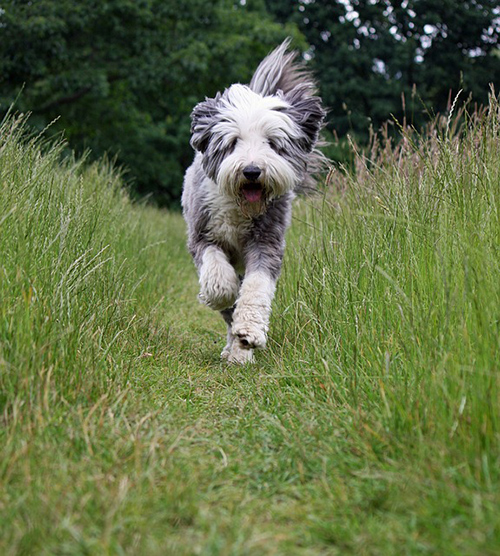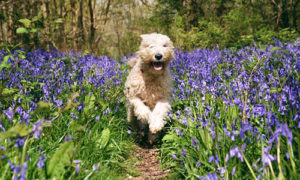
The Bearded Collie is considered a cross between other bearded dog breeds like the Lowland Polish Sheepdog and Central European Magyar Komodor. According to records, two Lowland Polish Sheepdogs were imported to Scotland via Polish traders in 1514. Though dogs resembled Bearded Collies depicted in art dating back to the 18th century, hard evidence of the dogs was not found until the early 19th century, when the first description of the breed was published.
Bearded Collies were tireless cattle drovers and sheepherders in the cold Scottish mists through rough terrain. Celebrated for its herding prowess in Scotland, the dog also became famous as a show dog after the Victorian Era. Two strains have since been merged and interbred into one breed: the Highland strain, which had white and gray coats, and the Border strain, which was white and brown with a wavy coat.
However, the Bearded Collies was again bred primarily for work after World War I. The dog’s value was so high at one point that it was almost impossible to get one from their shepherd owners. Thankfully, a small number of breeders interested in showing the dogs took some to England and then to the United States.
In 1977, the AKC recognized the breed. Since then, the Beardie has become a prominent show dog and is still used as a more than capable herding dog. However, it is more prevalent today in dog competition sports such as herding trials.

Breed Standard
The Bearded Collie is a dedicated working dog that is medium-sized, long, and athletic, covered by a long, protective shaggy coat. Its tail is long and can be carried low or level with the back. The skull is broad and flat, with hanging ears that lift slightly when the dog is alert. The eyes are large and wide-set to create a bright, inquiring expression. The breed’s distinctive beard has longer hair on the cheeks, lower lips, and chin.
Breed Facts
| Energy level | Watchdog ability | ||
| Exercise requirements | Protection ability | ||
| Playfulness | Grooming requirements | ||
| Affection level | Cold tolerance | ||
| Friendliness toward dogs | Heat tolerance | ||
| Friendliness toward other pets | Friendliness toward strangers | ||
| Ease of training |
- 1. Popularity: Uncommon
- 2. Family Group: Herding
- 3. Country of Origin: Scotland
- 4. Date Developed: 1800s
- 5. Original Purpose: Sheepherding
- 6. Current Function: Herding trials
- 7. Other Names: None

Activity Level: Moderate to high. This Collie requires daily exercise. It is playful and bouncy, but some are more active than others. The dog’s energy needs to be directed into structured activities, such as dog sports.
Grooming: Brushing daily will keep the coat free of dirt and matting. Most pet owners prefer to have the dog’s coat clipped for easier maintenance. Extra brushing will be needed during shedding season.
Coat: Shaggy, harsh, flat double coat

Color: These dogs come in black, brown, blue, or fawn and could have white and tan markings. The color typically tightens as the dog matures so that the adult Beardies can be seen in a variety of shades of the colors above.
Group: Herding
Year of recognition by the AKC: 1976
Bearded Collie Temperament

The Bearded Collie is well-known for its carefree and bouncy attitude. The dog is outgoing, affectionate, and individual temperaments range from lively and rambunctious to low-key and sweet. Beardies respond very well to positive reinforcement training methods because they are sensitive to harsh correction. Bearded Collies get along well with other pets.
The Bearded Collie is also intelligent, obedient, and an independent thinker with a clownish sense of humor. The dogs love children but can be too rambunctious for small children and may attempt to herd them.
Health
- Main Problems: none
- Minor Issues: CHD, epilepsy, colonic disease, pemphigus, Addison’s
- Rarely Seen: CHD, PRA, PPM, cataract, vWD
- Recommended Tests: hip, eye, thyroid
- Life Span: 12 to 14 years
- Weight: 45 to 55 pounds
- Height: male – 21 to 22 inches; female – 20 to 21 inches
Breeder and Buyer’s Advice

Potential owners need to be committed to grooming and tolerant of wet beards and muddy pawprints. Before buying a Bearded Collie puppy, ask all breeders about health certifications on the puppy’s mom and dad. According to the parent club, these dogs are just like snacks; you can’t have just one. The best way to find reputable breeders with Bearded Collie puppies for sale is to visit the parent club’s website. Most Beardie sales between 2020 and 2021 came from the breeders recommended by the parent club. The price of the puppies depends on that breeder and the dog’s pedigree.
Parent club: Bearded Collie Club of America; founded 1969
Regional clubs: Regional Bearded Collie Clubs are listed on the parent club’s website.
Rescue: Bearded Collie Club of America Beardie rescue is listed on the parent club website.




